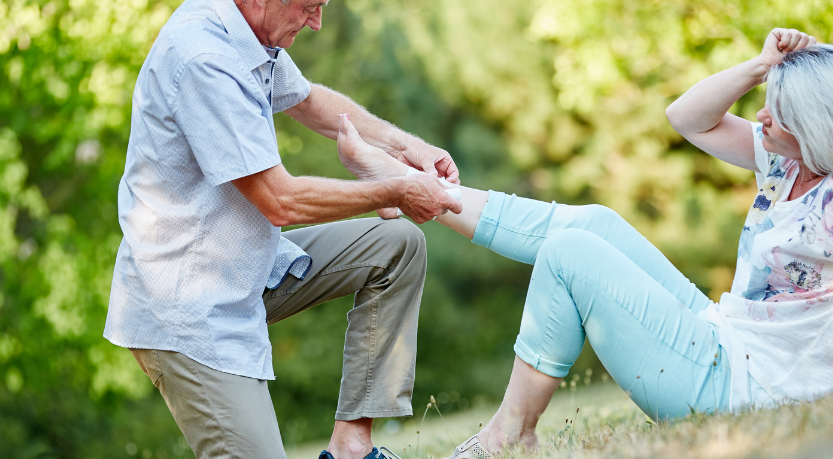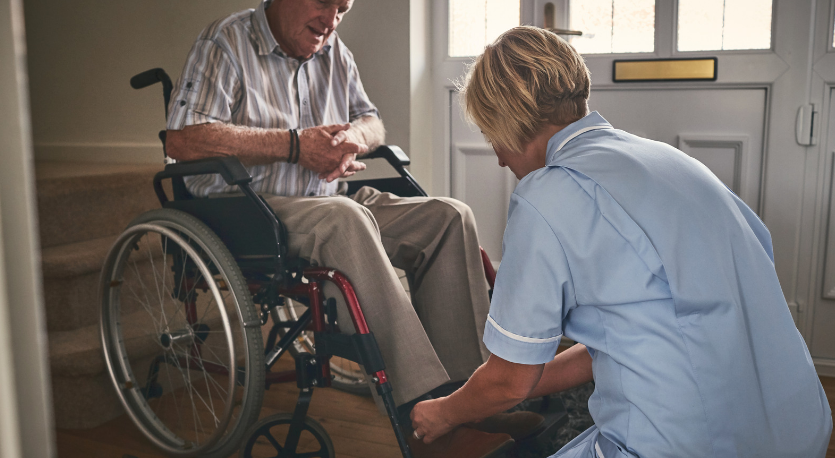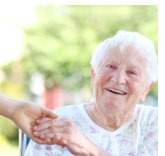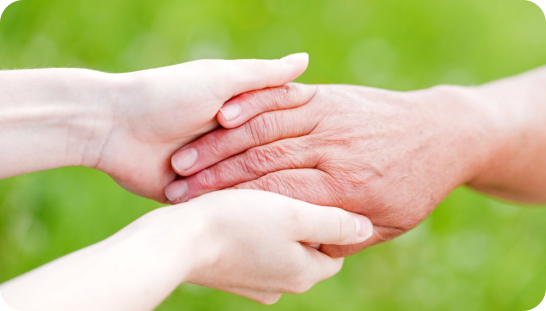Foot Problems In The Elderly And Fall Risk – What You Can Do About It

Foot problems in the elderly are a major concern. The elderly population is rapidly growing, and now there is a large group of people at risk for foot problems. These problems have increased in recent years since they affect balance and gait, increasing the risk of falling.
We can’t deny that elderly people have more problems than the young. Not only are they physically weaker, but they may also have more mobility problems and reduced concentration due to the influence of aging.
Reason for having foot pains and foot problems in the elderly:
- Gait
- Unbalanced posture
- Weakness of the bones
- Poor blood circulation
- Reduced sensation
- Inactivity, immobility
- Fatigue
- Aging
If the elderly people have all these problems, it’s no wonder that they’ll fall easily. They can’t feel how their feet get injured by things like a pebble on the floor or the sharp edge of a table or chair, so they are more prone to getting an injury that may develop into an ulcer of the foot.
What are the different foot problems the elderly suffer?

- Corns and calluses. Corns and calluses are some of the different foot problems elderlies suffer with; they cause a great deal of pain in their daily activities such as taking out shoes and walking around the house. They come about when skin folds repeatedly rub against the skin, causing redness, swelling, or pain.
- Bunions. It happens when your big toe turns or twists into the side of your foot, which can be painful and make walking difficult. They happen because the big toe gets pushed out of its position, and when you walk, it can feel like your toes are bumping into something when this happens. If you don’t get bunion treatment, they can worsen and require surgery. Women have a higher rate of bunions than males.
- Fungus in the feet. It’s an infection that forms when fungi grow out of control on moist skin. With no connection whatsoever to how often you wear socks or shoes, the fungus will eventually consume the skin on your soles if it’s left untreated.
- Hammertoe. This condition is basically when a person’s toes curve downward and meet at the end of their foot. It could be caused by wearing too-tight footwear, slippers, or house shoes for long periods. Such a condition can cause an individual to have difficulty walking, particularly if they have a problem with balance, which may lead to falls and other complications.
- Toenail problems. Toenail disease may arise due to infections, trauma, malnourishment, and other causes. It can cause pain, swelling, and even ulceration that hinders mobility.
- Plantar fasciitis. On the sole of your foot, the plantar fascia connects the heel bone to the toes. Inflammation of this area can make it difficult for you to walk, run, jump, or even just stand. Plantar fasciitis is one of the different foot problems that the elderly suffer from. It usually occurs when you are overweight or have had it in the past and need surgery to fix it.
Ways to Prevent Foot Problems and Fall Risk for the elderly
Half of the elderly population over age 65 will suffer from foot problems, so it’s no wonder these problems are on the rise with baby boomers. Not only will they be at risk of foot injuries that may even require surgery, but one in three seniors who live independently is likely to experience a fall per year. The good news is that there are ways to prevent both foot problems and falls.
1. Proper footwear

The first step in controlling foot problems is to wear proper footwear that fits properly. This means wearing a good-fitting shoe with adequate arch support and not wearing shoes with extra-high heels. Additionally, walking shoes are designed only to fit well on your foot, so people shouldn’t wear them with high arches or flat feet. If you wear orthotics, check with your doctor for the best fit for you.
The most important thing you can do as an individual is to ensure you have the proper footwear that fits well and supports your foot properly.
We don’t have an assurance of our health and the risk of falling. Fortunately, Serenity Senior Care is a service to make your life easier by offering our care and services to these people in the best way for them. We’re known for our reliable and prompt service. As a result, we provide this service to the people who need it and benefit from it.
2. Move around more
Taking a more active role in daily activities can make all the difference in helping keep your feet healthy. Experts recommend following these guidelines to help prevent problems:
Continue walking as much as you can, even if that means going on a walker. If you’re recovering from an injury, limit weight-bearing until fully healed or use crutches for support until your feet are strong enough to support your weight.
Even if you have good walking shoes, increase the time you walk by five to 10 extra minutes each day.
Exercise regularly. The more you exercise, the better your balance will be. If you sit most of the day at work, get up and walk around to let your muscles strengthen and keep your joints flexible. If possible, walk outdoors instead of inside a mall or office building. In general, taking regular walking breaks throughout the day also helps to keep your feet well-conditioned.
3. Regular visits to your doctor
For many people, it may be necessary to have a complete foot examination performed by a podiatrist. If you notice any ongoing problems, particularly pain, see your doctor for a more detailed assessment and possible treatment.
4. Monitor your weight loss

If you are overweight or obese, losing weight is important for keeping your feet healthy. However, due to the negative effects of obesity on the joints and muscles of the feet, it is also important to monitor your weight loss closely if you are overweight or obese so you don’t put your feet at risk by losing too much too quickly.
5. Avoid excessive alcohol use
Many elderly fall due to loss of balance or impaired coordination. These falls can result in injuries, chronic pain, and even death. Alcohol can reduce the protective effect of the skin and impair balance. Alcohol is also a stimulant that increases blood pressure and impairs judgment, often leading to falls or injury accidents. According to the findings, people with a low blood alcohol concentration have increased fall risk, while people with high alcohol content are related to increased injury risk.
Elderly people should avoid excessive alcohol use or drink less alcohol. When alcohol is consumed, it is not just the blood alcohol concentration that matters, but the blood concentration of the chemical component that affects the nervous system.
We tend to underestimate this effect because we usually think it is a non-toxic substance. People with a high tolerance to alcohol’s effects may lack awareness of the effects or be unaware of the alcohol itself.
6. Have regular eye exams
It is a common misconception that older people are less susceptible to foot problems because of their age. However, this makes it nearly impossible for the elderly to fall risk and injury. One way to prevent these troubles is by getting regular eye exams to detect any issues before they become chronic. Here are some tips on how to do so:
– Schedule your eye exam at least twice a year typically, with more if you have certain risk factors
– Make sure your doctor is aware that you have difficulty seeing properly or fear blindness which missed diagnoses might cause. You need to ask your doctor about these risks, or they won’t consider them.
– Call them regularly to ensure that you are receiving a good level of care.
– Make sure that you do not let yourself become blind. Have your eyes examined regularly to ensure your vision does not decline. It is particularly important for the elderly because they are at a higher risk than other age groups in the community.
7. High heel shoes
Wearing high heels can contribute to foot problems and may even need to be avoided because they cause pressure points on the bottom of the foot. The best approach is to wear thin shoes so that there’s not much rubbing but thick enough so that your feet can still fit inside them comfortably. It’s also important that you purchase comfortable shoes and fit your feet well since most high heels do not offer adequate support for flat feet or high arches.
8. Proper nutrition

Although food and nutrition play an important role in the health of the elderly, they are not to be ignored. A balanced diet is essential in supporting good general health and nails growth and repair and decreasing the risk of slow-healing sores. But you need to make sure you’re getting all the nutritional values you need from your diet by consuming various foods with different nutrients.
Eating a varied diet will help prevent vitamin deficiencies in seniors who lack specific vitamins or require them to avoid common illnesses. Even if older adults get enough calories, their bodies often cannot absorb them properly due to age-related changes that affect their ability to digest foods and absorb nutrients from these foods.
Final Thoughts
Prioritizing our health is a top priority for seniors, and the health and wellness of their feet are no exception. If you are concerned about your balance or are starting to feel pain in your upper or lower legs, it might be time to schedule a walk-in with your doctor.
Serenity Senior Care is dedicated to providing high-quality home care services to seniors who cannot perform their daily tasks. We offer a complete range of senior care services, including Alzheimer’s, dementia, Parkinson’s care, assisted living, and post-surgical recovery care.
If you or an aging loved one needs help with activities of daily living, please get in touch with us at 973-338-0124 for a free consultation.



One Response to Foot Problems In The Elderly And Fall Risk – What You Can Do About It